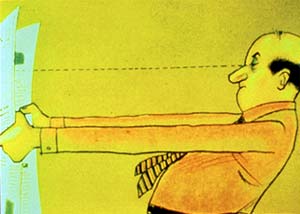Presbyopia

Presbyopia derives its name from a Greek word that literally means
'aging eye'. Presbyopia is a condition in which a person loses their
ability to focus on nearby objects because of aging changes that occur
in the eye. The exact changes are still undetermined but these changes
occur in almost everyone over forty years of age.
For one to see
images clearly, light rays enter the eye and are focused by the eye's
lens onto the retina. The lens changes shape to accommodate the
differences in light coming from objects at different distances; that
is, the lens changes its own prescription/power (much like changing
one's prescription glasses). However, due to normal aging processes, a
lot of body tissues lose their elasticity, including the lens and other
parts of the eye. Thus, these changes make it a lot harder to focus on
nearby objects.
It is of importance to note that although
presbyopia may seem to occur suddenly, the actual decline in focusing
ability takes place over the course of many years but it usually becomes
noticeable in the early to mid-forties.
Most people with
presbyopia first notice difficulty reading very fine print in the
newspaper, on prescription medicines, etc. Also, a lot of people find
that their eyes become easily fatigued when reading a book or computer
screen. Therefore, the most common symptoms of presbyopia are headaches
when doing close work and the need for brighter light to see clearly.
Some signs of presbyopia include the tendency to hold reading materials
at arm's length, as the vision gets blurred. This is also known as the 'short-arm-syndrome'.
Presbyopia is sometimes confused with
long-sightedness (hyperopia), as they produce similar signs and
symptoms. It is important to distinguish between these however, as
hyperopia occurs when the cornea is flatter or the eyeball is shorter
than a normal eye and it can occur at any age, whereas presbyopia is due
to a loss of flexibility of the eye in only older people (>40
years). Also, presbyopia can occur together with short-sightedness
(myopia), long-sightedness (hyperopia) or astigmatism in the same eye.
Treatment
Many
people over forty years of age self-diagnose presbyopia based on their
inability to read clearly at a distance that used to be natural and
comfortable. However, it is easy for optometrist or ophthalmologist to
diagnose presbyopia with a routine eye examination. After diagnosis,
treatment for presbyopia will depend on things like the patient's
occupation and daily activities. Glasses are usually used to treat
presbyopia, which aid with the focusing of the eye's lens. There are
four different types of glasses that are used including reading glasses,
bifocals, trifocals and multifocals (graduated). The final choice
greatly depends on the person's lifestyle and ability to adjust to that
particular type of lens. Contact Lenses are another option but are not
as successful as glasses. Laser surgery is another option, which means
patients won’t need glasses or contact lenses.
|